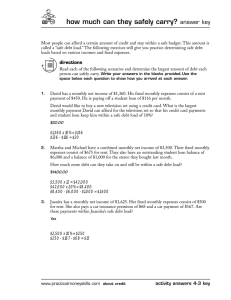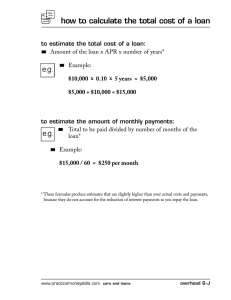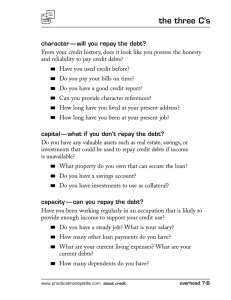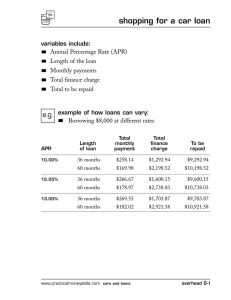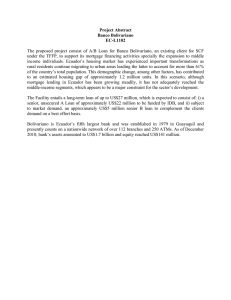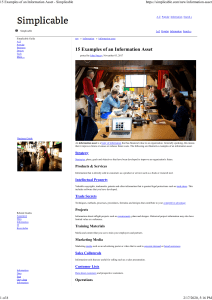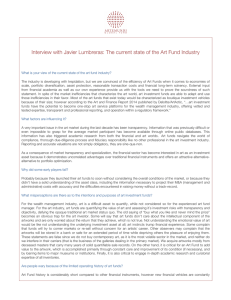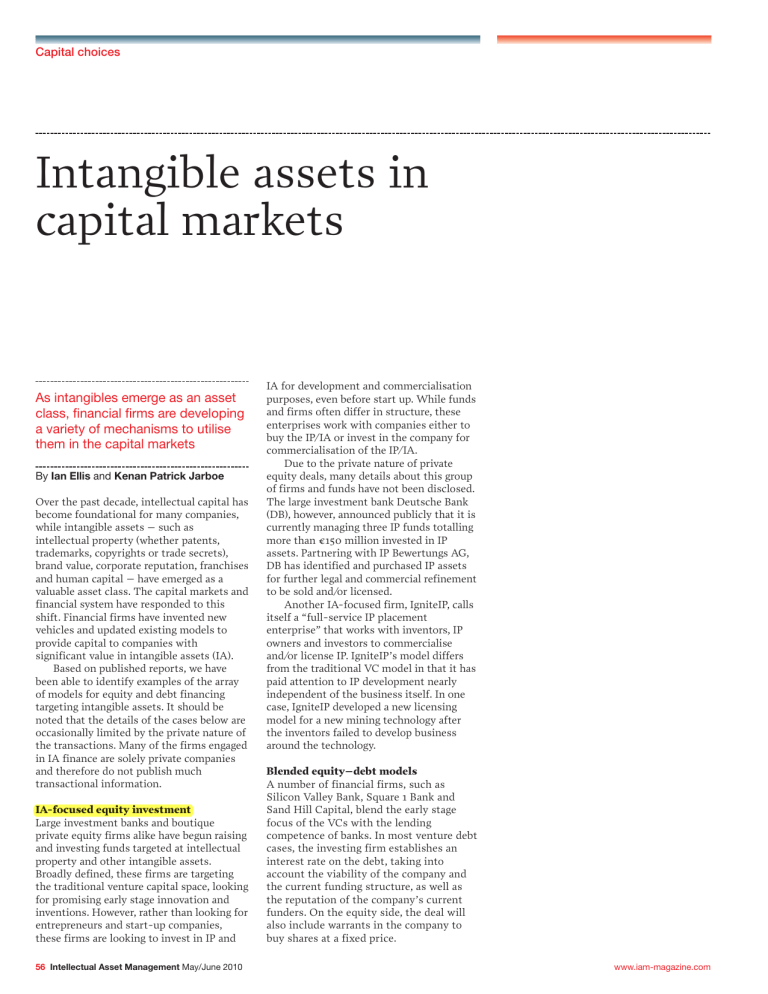
Capital choices Intangible assets in capital markets As intangibles emerge as an asset class, financial firms are developing a variety of mechanisms to utilise them in the capital markets By Ian Ellis and Kenan Patrick Jarboe Over the past decade, intellectual capital has become foundational for many companies, while intangible assets – such as intellectual property (whether patents, trademarks, copyrights or trade secrets), brand value, corporate reputation, franchises and human capital – have emerged as a valuable asset class. The capital markets and financial system have responded to this shift. Financial firms have invented new vehicles and updated existing models to provide capital to companies with significant value in intangible assets (IA). Based on published reports, we have been able to identify examples of the array of models for equity and debt financing targeting intangible assets. It should be noted that the details of the cases below are occasionally limited by the private nature of the transactions. Many of the firms engaged in IA finance are solely private companies and therefore do not publish much transactional information. IA-focused equity investment Large investment banks and boutique private equity firms alike have begun raising and investing funds targeted at intellectual property and other intangible assets. Broadly defined, these firms are targeting the traditional venture capital space, looking for promising early stage innovation and inventions. However, rather than looking for entrepreneurs and start-up companies, these firms are looking to invest in IP and 56 Intellectual Asset Management May/June 2010 IA for development and commercialisation purposes, even before start up. While funds and firms often differ in structure, these enterprises work with companies either to buy the IP/IA or invest in the company for commercialisation of the IP/IA. Due to the private nature of private equity deals, many details about this group of firms and funds have not been disclosed. The large investment bank Deutsche Bank (DB), however, announced publicly that it is currently managing three IP funds totalling more than €150 million invested in IP assets. Partnering with IP Bewertungs AG, DB has identified and purchased IP assets for further legal and commercial refinement to be sold and/or licensed. Another IA-focused firm, IgniteIP, calls itself a “full-service IP placement enterprise” that works with inventors, IP owners and investors to commercialise and/or license IP. IgniteIP’s model differs from the traditional VC model in that it has paid attention to IP development nearly independent of the business itself. In one case, IgniteIP developed a new licensing model for a new mining technology after the inventors failed to develop business around the technology. Blended equity–debt models A number of financial firms, such as Silicon Valley Bank, Square 1 Bank and Sand Hill Capital, blend the early stage focus of the VCs with the lending competence of banks. In most venture debt cases, the investing firm establishes an interest rate on the debt, taking into account the viability of the company and the current funding structure, as well as the reputation of the company’s current funders. On the equity side, the deal will also include warrants in the company to buy shares at a fixed price. www.iam-magazine.com Capital choices It is becoming more commonplace for IP assets to be written into the contracts governing broad asset-backed loans, either as a separate asset or as an integral part of overall company value There is another set of private equity firms that target investments in companies with a critical focus on IP and intangible assets. These firms are not necessarily targeting raw or undeveloped IP assets for the purpose of monetising the IP itself through licensing. Rather, they look for early stage or start-up companies with integral IP assets for the companies’ intended markets. In essence, these firms screen their deals by looking for critical IP and the overall cash flow the companies generate. These models also often utilise a hybrid approach to equity investing, similar to the venture debt market. For example, Altitude Capital has invested in 16 companies since the firm was created in July 2005. According to its promotional materials, it specifically invests in “portfolio companies that have valuable patents, trademarks/brands, copyrights, royalty streams, trade secrets, and other intangible assets, which will create a competitive advantage in creating value”. Altitude has structured a variety of transactions, providing common equity, preferred stock and subordinated or secured debt. For example, its investment in Intrinsity Inc. used an equity–debt combination of Class E preferred stock and senior secured notes with warrants. Newlight Capital is another firm focused on IP venture debt investments. Newlight’s model focuses on intellectual property because, the firm’s materials suggest, it is traditionally undervalued compared with accounts receivable, durable goods, inventory and so on. After Newlight values the IP, it issues a broad security package for a term loan with interest and warrants in the company. Intangible asset–backed lending Pure debt financing deals are secured by the assets of the company; for our purposes, its intangible assets. Asset-backed loans are the most straight forward debt instruments. Financial markets for asset-backed loans are www.iam-magazine.com already well developed and take many forms. Consumer loans, such as home mortgages and auto loans for individuals, are the staple of the credit and banking system. Inventory and equipment loans for businesses are available from either traditional banking sources or from specialised asset-based lenders. Specialised asset-based lending includes assets such as accounts receivable and extends from straightforward loans to complex lease-back arrangements. Similar to these transactions, intangible asset–backed loans (IABL) use IP or other intangible assets to secure a loan. Such financing may be rare but has a long history. The first trade secrets case in the United States involved the debt on a bond secured in part by a secret chocolate-making process in 1837. In 1884, Ara Shipman loaned Lewis Waterman US$5,000 to start a pen-manufacturing business, which was secured by Waterman’s patent. Much of intangible asset-backed lending may be invisible. Intangibles have always been included in a blanket lien on all assets. In these cases, the IA is not explicitly identified or incorporated into the terms of the loan. Thus, the collateral value of the assets is not recognised and the borrower may not receive all of the capital they could qualify for. However, it is becoming more commonplace for IP assets to be written into the contracts governing broad assetbacked loans, either as a separate asset or as an integral part of overall company value. For example, Smithfield Foods company received a US$1 billion revolving credit facility from JP Morgan that was secured by first-priority liens in the company’s and its US subsidiaries’ cash, intellectual property, equity interests in the subsidiary guarantors, inventory, accounts receivable and other personal property. In other words, intangibles were treated like any other asset. Companies can also arrange funding through a dedicated amount of IA-secured Intellectual Asset Management May/June 2010 57 Capital choices Figures 1. The intangible asset financing matrix Equity Models Intangible asset equity investments Debt Debt-equity blended models Description Equity investments focused nearly intangible exclusively on asset value Traditional bank lending utilising intangible assets as collateral for loans Example Cambridge Display Technology financed commercialisation through a loan secured by CDT’s patent portfolio Variations Flexible model that utilises both debt and equity structures to provide proper balance of security and liquidity Deutsche Bank/IP Altitude Capital portfolio Bewertungs Patent of investments include Value Funds combinations of common and preferred stock along with secured and subordinated debt Commercialisation funds Venture-Debt model that purchase intangibles where debt can be to commercialise IA transferred to equity upon meeting certain milestones Intangible asset-based lending debt within a broader lien structure, often a syndicated loan with multiple financial institutions. For example, Toys ‘R’ Us has a complex debt arrangement that includes loans secured by its real estate subsidiary, a secured-term loan based on the company’s intellectual property and a second lien on accounts receivable and inventory. The Toys ‘R’ Us example is a window into the barriers to IP-backed lending. A recent Fitch ratings report articulates the recovery prospects for its various tranches of debt. The IP-secured term loan is listed as less than 10% recoverable compared with real estate debt, which is seen as 71% to 90% recoverable. The unsecured debt was also listed at less than 10%. Clearly IP is still not seen as a highly recoverable asset; IP-secured loans are on par with unsecured debt. On the other hand, using IP to secure part of its debt may have given Toys ‘R’ Us access to otherwise unavailable capital. IA can also be used to enhance the original loan. For example, Belgium-based KBC Business Capital financed an IABL loan for Burn Stewart Distillers Limited to expand its international business marketing whisky brands. KBC retained Intangible Business, an IP financial services firm, to value Burn’s intangible assets and inventory, and was able to demonstrate the additional value of the brand assets when 58 Intellectual Asset Management May/June 2010 Securitisation or collateralising a securitisation of an intangible asset combined with the value of its real estate. Ultimately, KBC loaned Burn £31 million. But IA is not just an add-on financing tool. Companies can secure loans based primarily on their IA as well. For example, Paradox Capital in August 2008 provided an IABL to Snapware Corporation, which specialises in storage and organisation solutions for the home and kitchen with brands that include Snap ‘N Stack, Smart Store, mods, GlassLock, Airtight Canisters and Snap ‘N Serve. The financing relationship between Paradox and Snapware grew out of an initial IP-based loan provided more than a year before the August deal. After the relationship proved successful, Paradox Capital partnered with New Stream Capital to close the IABL for Snapware, supported by the storage company’s strong and ongoing investments in brand and product design. Taking an example from the creative arts sector, Intangible Business structured a deal with Boosey & Hawkes to expand its business publishing the rights to the works of composers. Boosey needed capital to purchase additional rights and Intangible Business agreed to provide the funding, which was secured by the rights Boosey already owned. Some firms specialising in IABLs will serve as a credit enhancement agent to a larger bank or firm that ultimately lends the www.iam-magazine.com Capital choices Intangible financing from 30,000 feet Although intangible financings are not as frequent as those backed by other assets, there is enough information out there to be able to come to some conclusions about them: • • • • • IA financing vehicles require flexibility and specialisation to account for differing and unique factors inherent in intangible assets. A robust market for IAs is necessary to ensure appropriate and accessible liquidation events for financial firms with both debt and equity positions, especially in distressed situations. The recent proliferation of IA licensing and sales, including auctions, has added depth to this market. But with low recovery rates currently standard, greater awareness is needed to ensure that companies’ and financial firms’ IAs are valued correctly, and licensed and sold at prices reflecting high return rates. Intangibles are important assets to be secured in lending and compared with the traditional assets of real estate, accounts receivable and inventory. Even financial firms specialising in IAs rightly evaluate investment opportunities within the broader view of the profitability and growth potential of a target business. These holistic due diligence processes, however, do not discount the independent value of many IA classes. Valuation methodologies for IAs are diverse and understandably imprecise; funds. These firms might partner with investment and commercial banks, and even private equity firms, to secure a line of credit for the target company to provide the larger institution with additional protections to offset the complexity and uncertainty surrounding IA valuations. The innovative flat-panel display technology maker Cambridge Display Technology (CDT), for instance, secured a US$15 million loan from Lloyds TSB, fully guaranteed by the credit enhancement firm IP Innovations (IPI) Financial Services Inc. According to published reports, IPI secured the loan on the “strength of CDT’s patent portfolio, extensive licensing history, unprecedented upfront licensing fees, size and growth trajectory of the market for the products supported by the PLED patents, and the level of industry wide investment in the commercialisation of the technology to date”. IPI financed a similar deal in 2004 for ATD Corporation, a Georgia-based company www.iam-magazine.com • • • however, conservative loan-to-value ratios, advance rates and other debt-andequity protocols allow firms to account for the inherent imprecision of IA valuations. Intangible assets, as an asset class, provide financial firms with flexibility in structuring deals, allowing for both debtand-equity vehicles and hybrid models. These vehicles can be adapted to address financing requirements for companies of all sizes and needs. The securitisation market for intangibles, while currently suffering from the same problems plaguing the overall securitisation market, provides additional mechanisms for companies with IAlicensing businesses. These companies can use a debt model to generate cash flow for positive assets or, more likely, use an equity model for pre-commercial phase assets. The development of financial products based on intangible assets is not the next exotic financial vehicle. The financial products discussed in this article are some of the most basic financing mechanisms in business. The innovation is in recognising the value of intangible assets for corporate finance. that supplies acoustic and thermal insulation products to the automatic appliance and barbecue industries. The entire US$2 million loan by GMAC Commercial Finance was secured by the company’s patents, trademarks and related licensing revenue. The IABL was additional and separate from the working capital loans secured by accounts receivable and inventory, with only the IABL piece covered by IPI’s credit enhancement guarantee. Royalty financing In recent years, a variation on IABL known as royalty financing arrangements have been come increasingly useful, especially in the pharmaceutical and biotechnology sectors. As Jeffrey A Jung and John P Tamisiea have pointed out in an article in The Deal Magazine, these financings come in two forms – royalty interest and revenue interest (or synthetic royalty) transactions. In these cases, the funding is specifically Intellectual Asset Management May/June 2010 59 Capital choices backed by the current or prospective royalty stream, similar to a securitisation transaction. Unlike a securitisation, however, the loans are generally not bundled and sold to the general public, but held by a speciality investment fund. A royalty interest transaction allows a company to sell the rights to an investor for cash up front or to sell a percentage of the rights for cash up front while still retaining a partial right to future royalty revenue. Either way, the investor is attempting to purchase the royalty revenue stream at a discount from what it will pay over its life. The revenue interest model follows the same structure but is simply executed earlier in the life of the patented or copyrighted entity – for the purposes of this definition, before the royalties have generated any revenue. Because the royalty has yet to generate revenue, the investing institution generally negotiates more favourable terms for itself due to the greater level of risk, which may include an equity position as well. Ultimately, the Online Registration and programme details: www.irfs.at investor pays the rights’ holder for part or all of the prospective royalty revenue stream in exchange for the rights to future royalty pay days. According to Jung and Tamisiea, the number of these financing transactions has grown dramatically in recent years. In 2000, there was one publicly announced royalty interest deal and one publicly announced revenue interest transaction, totalling US$145 million in investments. Contrast that with the 2007–2008 period, when there were 27 publicly announced transactions: 19 royalty interest transactions; five revenue interest transactions; and three hybrid transactions using multiple financing techniques including royalty financing. The value of all these deals was US$3.3 billion. Leading firms in this field include Capital Royalty LP, Cowen Healthcare Royalty Partners, DRI Capital Inc, Paul Capital Healthcare and Royalty Pharma. The story of XOMA, a human antibody therapeutics technology company, illustrates the process of the royalty interest version. 1 JUNE 2010 /// VIENNA /// AUSTRIA STRATEGIC SEMINAR USING IP AS AN INDICATOR OF R&D STRATEGY Meet an exceptional international panel of successful executives and managers. Explore Intellectual Property policies and innovative decision-making breakthroughs. Get updated over cost-effective optimizations for managing the performance of your IP department and R&D branch. Information Retrieval Facility The Science and Industry Platform for a Sustainable Innovation Cycle 60 Intellectual Asset Management May/June 2010 Topics include: • The impact of Intellectual Property policies on innovation and competition European and global perspectives: Manuel Desantes (Professor, former Vice-President of the European Patent Office) • Setting up a corporate IP department: Frank Cuypers (PricewaterhouseCoopers) • Promoting Innovation: Innovation management and IP audit: Desai Narasimhalu (Director, Institute of Innovation and Entrepreneurship, Singapore Management University) • Assessing patents to measure the effectiveness of R&D: Holger Ernst (Chair for Technology and Innovation Management, Otto Beisheim School of Management) • Assessing the value of IP: Anthony Trippe (Director, IP Analytics, 3LP Advisors) This all-day seminar will be rounded up by a best practice session with presentations by Gerald Landl (Head of IP & Standards, voestalpine), David Walsh (Information Specialist for patent & chemistry, Pfizer), Pekka Sääskilahti (Senior Economist Legal and IP, Nokia Corporation) and Martin Bader (Managing Partner, BGW Management Advisory Group). The Strategic Seminar is organized by the Information Retrieval Facility in collocation with the 3rd IRF Symposium. More information at www.irfs.at www.iam-magazine.com Capital choices A royalty interest transaction allows a company to sell the rights to an investor for cash up front or to sell a percentage of the rights for cash up front while still retaining a partial right to future royalty revenue In 1996, XOMA had negotiated an exclusive licence with Genentech for one of its technologies. In 1997, Royalty Pharma purchased the patents and royalty rights, providing XOMA with immediate capital while Royalty Pharma got the stream of royalty payments from Genentech. In 2006, XOMA entered into a five-year loan facility with Goldman Sachs Specialty Lending Group, borrowing US$35 million. The loan was structured for an annual rate of six-month LIBOR plus 5.25% secured by all rights to receive payments due to XOMA relating to XOMA’s drugs Raptiva, Lucentis, and Cimzia. Royalty payments received by XOMA were to be used to make the semiannual interest payment to Goldman, with any additional amounts used to pay down the principal at the lender’s discretion. In May 2008, XOMA refinanced its loan with Goldman to borrow US$55 million. The loan is secured by the royalty revenues XOMA receives from sales of the three brand-name drugs. Using proceeds from the new five-year loan, XOMA paid off the remaining US$22.1 million in principal from the original 2006 royalty-based Goldman loan as well as transaction-related fees and expenses. The story of XOMA’s creative financial arrangements demonstrates the IA-based financing options available to companies. XOMA’s IP assets and associated revenues from its groundbreaking research and development (R&D) allowed it to enter into collaborative R&D and financing agreements with Genentech and to make loan arrangements with Royalty Pharma and Goldman Sachs. However, negative developments relating to XOMA’s business show the flip side of IP financing. An adverse public health advisory issued by the US Food and Drug Administration (FDA) in February www.iam-magazine.com 2009 on Raptiva, linking the drug to a rare brain infection, all but eliminated XOMA’s royalty revenue from the Genentech contract, which also affected the securitisation for the Goldman Sachs loan. XOMA subsequently restructured its finances and paid off the Goldman loan in September 2009, in part through a US$25 million buyout by Genentech of XOMA’s royalty interest in Lucentis. Despite XOMA’s recent struggles, its case demonstrates the viability of a securitised intangible asset–backed loans: the company successfully securitised, sold, and lent against its royalty revenue over the last decade. Alternate model – sale and lease back Apart from the debt-and-equity financing arrangements, the sale lease-back model is worth considering for companies looking to raise capital for further innovation and business development. The sale lease-back is employed by some companies to secure short-term funding by selling a portfolio of IP to a firm along with an agreement to receive a licence for the IP to continue commercialisation and business operations. The company receives immediate funding to reinvest in the business, and the licensing firm structures the contract to pursue continued monetisation of the asset. VocalTec Communications Ltd., an Israeli telecommunications company, for example, sold the rights to 15 of its 22 inventions in January 2009 to raise cash to market its main internet phone software. VocalTec reported US$5.8 million in 2007 revenue but decided to dispose of its consumer phone patents to focus on sales, using the money from the transaction to fund this business development effort. The VocalTec case demonstrates that companies may consider it in their best Intellectual Asset Management May/June 2010 61 Capital choices interests to jettison all or part of their IP in favour of a lump-sum cash payment. While most companies wish to retain their rights – whether for royalty revenues, technical market protection or brand preservation – some will decide they will not suffer if they do not own their IP. These alternative and hybrid models show the adaptability of financial firms to structure IA-focused instruments to meet the needs of companies. Intangibles are a truly legitimate asset class that can be treated like other asset classes, with financial products of all structures able to be arranged to meet any given company’s capitalisation requirements. A maturing market As we can see from these case studies, there is a place for intangible asset (IA) investments in the capital allocation process, even if it is not yet mature. IA-based finance will only develop if its valuations can compete with other asset classes, if it can rely on a variety of liquidation mechanisms and if a number of mainstream financial firms get involved in this exciting market. The maturation of this market will prove to be a valuable innovation in finance. Today’s most promising companies are built on intangible assets. This new wave of business growth requires the finance community to develop the robust financial products to fund these companies. A market for IA-focused financial services is vital to foster continued innovation and economic growth. Ian Ellis is a master of business administration candidate at the University of Chicago Booth School of Business. Kenan Patrick Jarboe is president of the Athena Alliance (www.athenaalliance.org) Your Experts for Intellectual Property SKW Schwarz Rechtsanwälte is an independent German law ÄYT>LHK]PZL.LYTHUHUK international clients of all industries nationally and, through V\YUL[^VYRVMMVYLPNUSH^ÄYTZ HSZVNSVIHSS` – – – – – – – – – ¶ trademark prosecution trademark litigation designs patents copyrights domain names licensing unfair competition law competition/antitrust LTWSV`LLPU]LU[PVUZ www.skwschwarz.de Berlin Düsseldorf Frankfurt / Main Hamburg München 62 Intellectual Asset Management May/June 2010 www.iam-magazine.com
